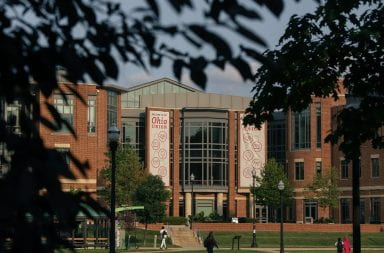
Hale Hall has been the gathering space for the Black Ohio State community for 31 years, but due to COVID-19 guidelines, the building was converted from a student center and gathering space into a classroom building. Credit: Mackenzie Shanklin | Photo Editor
Nnaemeka Anene, a fourth-year in material science and engineering, said he will miss much when he graduates from Ohio State.
But one of the places he will miss most of all has already been taken from him.
Hale Hall has been the gathering space for the Black Ohio State community for 31 years, but due to COVID-19 guidelines, the building was converted from a student center and gathering space into a classroom building, Larry Williamson Jr., director of the Office of Diversity and Inclusion and Frank W. Hale Jr. Black Cultural Center, said. Anene and other Black students said they acutely feel this loss because they have long viewed Hale Hall as a home.
“We typically are a student center where students will come in and interact and do the programs that were needed for them to achieve their goals and objectives at Ohio State,” Williamson said.
Hale Hall was established in 1989 and named after Frank Hale Jr., former vice provost for Diversity and Inclusion and professor emeritus at Ohio State, who dedicated his years at Ohio State to creating opportunities for Black students and students of color while also carving out safe spaces for them.
Williamson said Hale Hall is a Black cultural center that resulted from Black students fighting to have their own space on campus. The site is one of four on campus considered historically significant by the National Register of Historic Places.
“Our golden objective is to facilitate the spirits of all students, but specifically African American students in their cultural, social and educational growth throughout the Ohio State University,” Williamson said.
He said the loss of the space resonates throughout the Black Ohio State community.
“Oftentimes people forget the importance of having a space that’s there for a community, and when it no longer functions the way it normally does, it can really change the dynamics considerably,” Williamson said.
Ocean Coldren, a third-year in business marketing and president of the Black Student Association at Ohio State, said Hale Hall provides a space for Black students at Ohio State that feels like a historically Black college or university within a predominantly white institution.
“It gives an HBCU feel because you can go there and be completely around people who look like you, so if you want a community feel in a PWI, it’s a great place to get that community,” Coldren said.
Ohio State’s main campus has a total of 46,984 undergraduate students as of the 15th day of the fall semester, according to the fall 2020 15th day enrollment report. White students make up 30,842 of the total undergraduate student population of the main campus.
Black students account for 3,378 of the undergraduate students on Ohio State’s main campus — just 7 percent of the undergraduate population — according to the report. This is up from 3,138 from the 2019 fall semester.
Tziporah Tiller, a fourth-year in political science and public affairs, said she has spent a lot of time in Hale Hall over the past four years, attending meetings, studying or congregating with friends.
Tiller said she misses Hale Hall but feels worse for her sister, a freshman, who does not have the space to call home during her first year on campus.
Anene, an elite ambassador for Bell National Resource Center on the African American Male at Ohio State, said social media, specifically the “bOSU” GroupMe group chat, which consists of more than 2,000 Black Ohio State students, has been key to keeping the Black Ohio State community together without Hale Hall.
“bOSU was used for conversation in the past, but I think it is really reliable for people to connect and talk about things now,” Anene said. “GroupMe is like Hale, in a sense.”
Anene said the spirit of Hale Hall lives with Black student organizations who continue to have their meetings via Zoom, which has been important for maintaining connections in the Black Ohio State community.
“Whether it is having really interactive events or being able to have discussions in breakout rooms and use those different features, at the end of the day, Zoom is the best way to get people together,” Anene said.
For the time being, Zoom will have to do.
Williamson said it is unknown when Hale Hall will be able to return to its normal usage due to university guidelines. In the meantime, he is working with students and student organizations to make sure they are successful now and know they will have a home when Hale Hall returns.
“We’re still trying to stay involved, and we reach out to our student organizations about how we can be supportive with a clear understanding that when we get back to normalcy, come on back home, because you have your space,” Williamson said.


